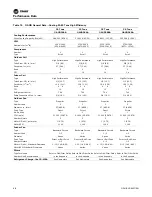
36
OAU-SVX005C-EN
Maintenance
Make sure all personnel are standing clear of the unit
before proceeding. The system components will start
when the power is applied.
Monthly Maintenance
Before completing the following checks, turn the unit OFF
and lock the main power disconnect switch open.
Filters
•
Inspect the return air filters. Clean or replace them if
necessary. Refer to the unit Service Facts for filter
information.
Supply/Return Air Smoke Detector
Maintenance
Airflow through the unit is affected by the amount of dirt
and debris accumulated on the indoor coil and filters.
To insure that airflow through the unit is adequate for
proper sampling by the return air smoke detector,
complete adherence to the maintenance procedures,
including recommended intervals between filter changes,
and coil cleaning is required.
Periodic checks and maintenance procedures must be
performed on the smoke detector to insure that it will
function properly.
For detailed instructions concerning these checks and
procedures, refer to the appropriate section(s) of the
smoke detector Installation and Maintenance Instructions
provided with the literature package for this unit.
Cooling Season
•
Check the unit’s drain pans and condensate piping to
ensure that there are no blockages.
•
Inspect the evaporator and condenser coils for dirt,
bent fins, etc. If the coils appear dirty, clean them
according to the instructions described in
•
Manually rotate the condenser fan(s) to ensure free
movement and check motor bearings for wear. Verify
that all of the fan mounting hardware is tight.
•
Inspect the F/A-R/A damper hinges and pins to ensure
that all moving parts are securely mounted. Keep the
blades clean as necessary.
•
Verify that all damper linkages move freely; lubricate
with white grease, if necessary.
•
Check supply fan motor bearings; repair or replace the
motor as necessary.
•
Check the fan shaft bearings for wear. Replace the
bearings as necessary.
•
Verify that all wire terminal connections are tight.
•
Remove any corrosion present on the exterior surfaces
of the unit and repaint these areas.
•
Generally inspect the unit for unusual conditions (e.g.,
loose access panels, leaking piping connections, etc.).
•
Make sure that all retaining screws are reinstalled in
the unit access panels once these checks are complete.
•
With the unit running, check and record the: ambient
temperature; compressor suction and discharge
pressures; superheat; Record this data on an
“operator’s maintenance log” like the one shown in
. If the operating pressures indicate a
refrigerant shortage, measure the system superheat.
Note:
Do NOT release refrigerant to the atmosphere! If
adding or removing refrigerant is required, the
service technician must comply with all federal,
state and local laws.
Heating Season
•
Inspect the unit’s air filters. If necessary, clean or
replace them.
•
Check supply fan motor bearings; repair or replace the
motor as necessary.
•
Inspect both the main unit control panel and heat
section control box for loose electrical components
and terminal connections, as well as damaged wire
insulation. Make any necessary repairs.
•
Refer to
and Maintenance of Gas Ports,” p. 43
Condenser Coil Cleaning
Regular coil maintenance, including annual cleaning,
enhances the unit’s operating efficiency by minimizing:
compressor head pressure and amperage draw;
evaporator water carryover; fan brake horsepower, due to
increase static pressure losses; airflow reduction.
WARNING
Hazardous Voltage!
Failure to disconnect power before servicing could
result in death or serious injury. Disconnect all electric
power, including remote disconnects before servicing.
Follow proper lockout/tagout procedures to ensure the
power can not be inadvertently energized.
AVERTISSEMENT
Risque d’électrocution!
Le non-respect de cette consigne peut entraîner des
blessures graves, voire mortelles. Avant toute
intervention, coupez l’alimentation électrique, y
compris aux sectionneurs à distance. Suivez
scrupuleusement les procédures de verrouillage/mise
hors service préconisées pour empêcher tout
rétablissement accidentel de l’alimentation électrique.















































